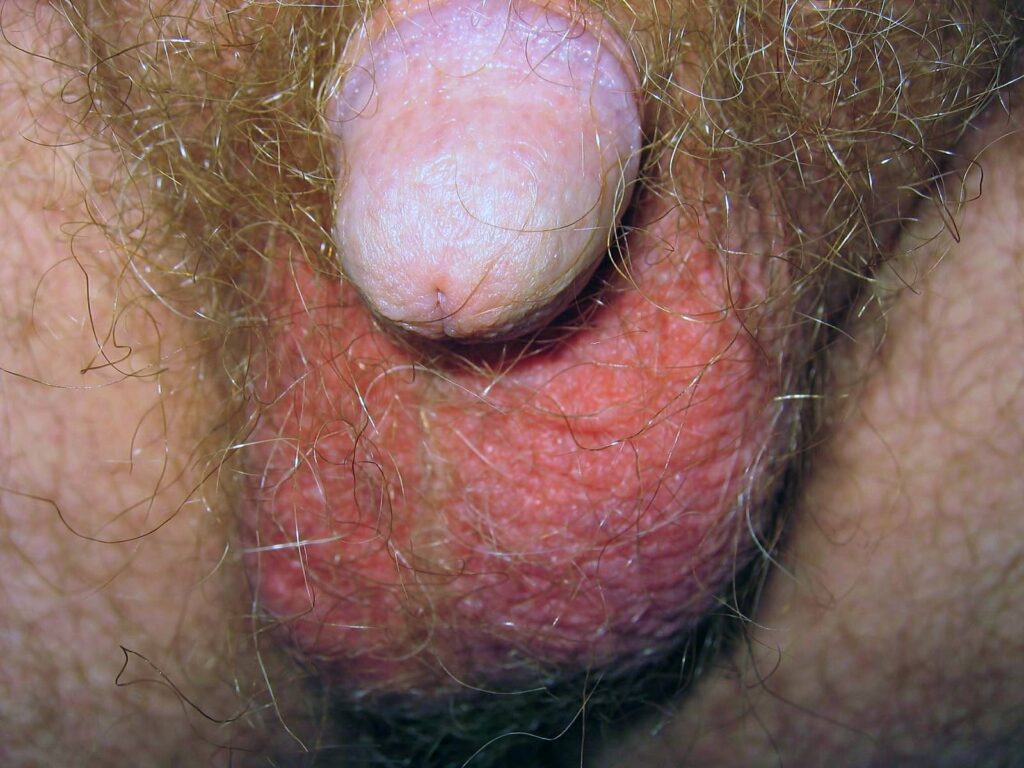Dr. Ted Rosen discusses a comprehensive literature-based review that puts red scrotum, the “uncommon but terribly distressing disorder” syndrome, into perspective.

Ted Rosen, MD, FAAD
Professor of Dermatology, Baylor College of Medicine, Houston, Texas
“As [Khalil S., et al] point out, the precise cause of red scrotum syndrome remains unknown. Leading theories include rebound vasodilation following prolonged application of topical corticosteroids, localized primary erythromelalgia, and neurogenic inflammation.”
The first of these hypotheses revolves around release of cutaneous stores of nitric acid that have been synthesized to combat steroid-induced vasoconstriction. The second hypothesis is related to small and large fiber neuropathy associated with increased local blood flow. These findings in erythromelalgia often have triggering factors such as exposure to extremes of temperature, intensive physical activity, emotional stress, alcohol abuse, or smoking. The final hypothesis invokes inflammation due to sensory nerve release of neuropeptides which, in turn, leads to release of proinflammatory cytokines and chemokines, said Dr. Rosen.
“While each of these hypotheses partially explains and correlates with the clinical findings seen in red scrotum syndrome, none is completely adequate.”
Physical examination should disclose well-demarcated erythema involving the anterior half of the scrotum. Erythema may extend to the posterior scrotal skin as well as to the proximal penile shaft. There may be cutaneous atrophy and telangiectasias, especially when the history discloses topical steroid use, said Dr. Rosen.
“Involved skin may be tender to the touch and is subject to a subjective burning sensation or hyperalgesia. Histologic findings are nonspecific and may include vascular dilation and a sparse perivascular and interstitial lymphocytic infiltrate.”
Diagnosis is basically one of exclusion, according to Dr. Rosen.
“Many common diseases should be ruled out by personal and family history, physical examination, cultures/smears, a Wood’s lamp examination, patch testing, and biopsy.”
Disorders to consider in the differential include allergic and irritant contact dermatitis, candidiasis and tinea cruris, erythrasma, inverse psoriasis and seborrhea, atopic dermatitis, extramammary Paget’s disease, and fixed drug eruption, said Dr. Rosen.
“Management of red scrotum syndrome is difficult. The first step should always consist of discontinuation of any topical corticosteroid use.”
Steroid “withdrawal” may initially exacerbate symptoms for a few months to over a year, he said.
“There are no large scale, controlled studies to rely upon when selecting specific therapeutic interventions. [There are] only case reports, small case series, and anecdotal reports.”
Some suggested treatments include oral and topical β-blockers (carvedilol and timolol maleate 0.5% gel, respectively), oral doxycycline, neuroleptic drugs (such a gabapentin and pregabalin), and potent oral nonsteroidal anti-inflammatory drugs (NSAIDs) (indomethacin), said Dr. Rosen.
“β-blockers may work by interfering with β2-adrenoreseptors, thereby inducing vasoconstriction. Doxycycline may offer some relief in 2 to 4 weeks and complete resolution in about 4 months. This drug is likely exerting benefit due to known anti-inflammatory properties. Gabapentin and pregabalin may be helpful due to their binding to a critical subunit of voltage-dependent calcium channels within neurons, thereby interfering with aberrant nerve signaling. Indomethacin may be useful due to potent anti-inflammatory properties.”
Despite literature favoring each of these interventions, none is guaranteed to be successful. Trial and error tactics are entirely appropriate for each individual so afflicted, said Dr. Rosen.
Reference:
Khalil S, Kurban M, Abbas O. Red scrotum syndrome: An update on clinicopathologic features, pathogenesis, diagnosis, and management. J Am Acad Dermatol. 2022 Sep;87(3):614-622. doi: 10.1016/j.jaad.2020.05.113. Epub 2020 Jun 1. PMID: 32497688.


